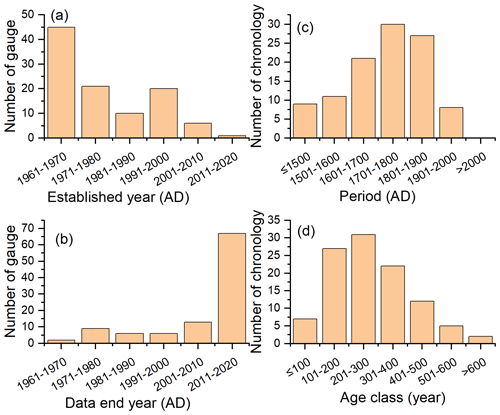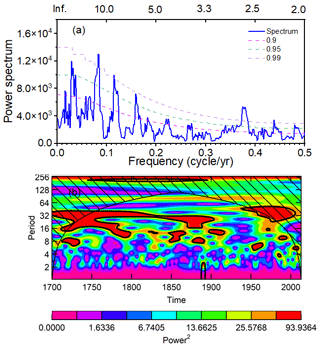the Creative Commons Attribution 4.0 License.
the Creative Commons Attribution 4.0 License.
Potential of tree-ring chronologies for multi-centennial streamflow reconstructions: an insight from Nepal
Yub R. Dhakal
Santosh K. Shah
Ze-Xin Fan
Rivers in the Himalayan and adjacent mountain regions are the lifelines of over 1 billion people and are the backbone of civilizations therein. The short gauge records of Nepal do not provide a sufficient time window to understand the natural variations in river discharge from a long-term climate perspective. By developing a network of over 100 tree-ring chronologies across Nepal, we checked their hydrological sensitivity for long-term streamflow reconstruction. This shows huge potential for long-term annual or seasonal streamflow reconstructions in different river basins of Nepal. A robust reconstruction model was developed between tree growth and streamflow, capturing 56 % of the variance in the actual data, and was used to reconstruct the March–July monthly average streamflow of Sinja Khola (river) at Diware from AD 1700 to 2013. The reconstruction revealed several dry and pluvial periods with the recent decline in the streamflow in the Sinja River. We found short- (2 to 8.7 years) to medium-term (35.2 years) periodicities in the reconstruction that are likely to be associated with climatic oscillations, such as the El Niño–Southern Oscillation (ENSO), the Atlantic Multidecadal Oscillation (AMO), and the North Atlantic Oscillation (NAO), along with the influence of local circulation patterns. Since Sinja Valley is related to the origin of the Nepali language and civilization, the information on long-term streamflow will be beneficial for water resource management in the context of rapid climate change and for preparedness for water-induced disasters in the region.
- Article
(3065 KB) - Full-text XML
- BibTeX
- EndNote
Climate change is an essential issue for the Hindu Kush Himalaya (HKH) region, which is witnessing a rapid increase in temperature, one that is more significant than the global average, along with increasing extremes in temperature and precipitation (DHM, 2017; Talchabhadel et al., 2018; ICIMOD, 2023). The ongoing climate change has left several bio-physical imprints in the HKH region (Chaudhary et al., 2023; Gaire et al., 2023; ICIMOD, 2023). The Himalayas and the adjacent mountains, the water towers of Asia, provide different ecosystem services and benefit more than 2 billion people in the river basins of the region (Immerzeel et al., 2010; ICIMOD, 2023); they are being severely affected by rapid climate change in the area. Research pointed out a marked reduction in water availability due to the shrinking of glaciers (Bolch et al., 2012; ICIMOD, 2023). However, modelling studies indicated an increasing river flow in the HKH rivers until the mid-21st century (Mathison et al., 2015).
Nepal harbours over 6000 rivers and rivulets, with the Karnali, Gandaki, and Koshi being three major river systems. The short river gauge station datasets in Nepal create a gap in understanding the long-term variations in river discharge. The long-term quantitative hydro-climatic variations are imperative for water resource management for different sectors, including agriculture, water and energy resources, biodiversity conservation, accurate design of infrastructures, and formulation of appropriate adaptation measures against climate change impacts and other disasters.
Nepal has several annual tree-ring-producing moisture-sensitive tree taxa, which are sources of high-resolution climate proxy information for long-term hydro-climatic reconstructions (Gaire et al., 2017, 2019; Liang et al., 2019; Panthi et al., 2017). Reconstructions of the magnitude, intensity, and periodicity of streamflow variability at different temporal scales provide a robust basis for planning water resources for recently implemented hydropower and irrigation projects in Nepal. Therefore, this study aims to provide the hydrological reconstruction potential of existing tree-ring chronology networks from Nepal and to reconstruct multi-centennial long streamflows in Nepal's rivers.
2.1 Hydrological data
Available hydrological data closer to the tree-ring sampling sites were collected from the Department of Hydrology and Meteorology, Government of Nepal.
2.2 Collection and analysis of tree-ring data
Tree-ring data were collected from both primary and secondary sources. All publicly available existing tree-ring chronologies were collected from public repositories: the International Tree-Ring Data Bank (ITRDB) and the National Oceanic and Atmospheric Administrations (https://www.ncei.noaa.gov/products/paleoclimatology/tree-ring, last access: 11 March 2019). In addition, new tree-ring chronologies were developed from our sample collection. Tree core samples were analysed in the lab following standard procedure (Fritts, 1976). Each ring of all the core samples was counted, dated, and measured and cross-dated using the LinTabTM measuring system attached to a computer with the TSAP-Win package (Rinn, 2013). The accuracy of cross-dating and measurement was further checked using the COFECHA programme. Standardization in ARSTAN and dplR (Bunn, 2008) was done for raw tree-ring width series to remove the trend in the raw chronology related to the tree age and geometry and to maximize the common signal likely to be associated with climate (Fritts, 1976). The various chronology statistics were calculated to assess the quality and dendroclimatic potential of the developed individual site or composite chronologies (Fritts, 1976; Wigley et al., 1984). Composite chronologies were created by combining the individual site chronologies showing similar growth trends and climatic responses or by combining chronologies of the same river catchments.
2.3 Hydro-climate sensitivity and response analysis and long-streamflow reconstruction
To establish growth–climate relationships and to identify growth-limiting climatic factors, simple and bootstrapped correlation analyses were carried out between hydro-climate (temperature, precipitation, and streamflow) and tree-ring chronology (Zang and Biondi, 2015). Later, a significant response was used to develop a regression model for the reconstruction of the past hydro-climate of the target variable and target season. For this study, we presented the spring–early-summer season (March–July) streamflow reconstruction of Sinja Khola (a tributary of Karnali River) at Diware station in Jumla as an example of the application of tree rings for long-term streamflow studies. The reconstruction was verified using leave-one-out cross-validation (Michaelsen, 1987) using various calibration–verification statistics (Fritts, 1976; Cook and Kairiukstis, 1990). The reconstruction was truncated at the point at which the EPS value became less than the arbitrary but commonly used threshold value (Wigley et al., 1984). Power spectral analysis using the multi-tapered method and the Morlet global wavelet analysis was performed to detect and analyse periodicities of the reconstructed streamflow series and to establish possible teleconnection patterns with a broader-scale circulation system or climate mode (Bunn, 2008).
3.1 Spatio-temporal distribution of tree-ring chronology and hydrological station networks in Nepal
We developed a network of 106 tree-ring chronologies using 12 annual tree-ring-producing tree taxa distributed in an elevation range from 1220 to 4100 m (Fig. 1). The average starting calendar date of the chronology was AD 1715 (median = 1733), and the average end date of the chronology was AD 2005 (median = 2011) (Fig. 2). The data of river gauge stations (103 stations) of Nepal cover from 1962 to 2020 (Figs. 1 and 2). Some stations are already closed, as indicated by Fig. 2. Some cover data for only a few years.
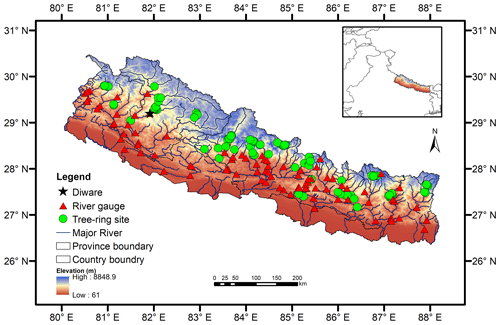
Figure 1Spatial distribution of tree-ring width chronology (circular symbols) and river gauge station (triangles) networks in Nepal and Diware gauge station (star) in Jumla. Publisher's remark: please note that the above figure contains disputed territories.
3.2 Hydrological sensitivity or potential of tree-ring chronologies
Our chronology network incorporates dendro-climatically suitable species and can contribute to extending the short hydrological records. The hydrological responses of tree-ring sites or regional composite chronologies revealed significant correlations with the monthly discharge of different months and seasons (Fig. 3). Our chronology showed significant responses with the monthly and seasonal streamflow at more than 30 river gauge stations; however, the response of many of the rivers is not strong enough to proceed with the reconstruction. Most of the tree-ring chronologies from the eastern and central parts of Nepal are relatively weakly correlated with the streamflow. However, several tree-ring chronologies from the western region revealed strong hydrological signals (Fig. 3).
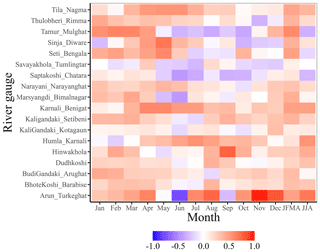
Figure 3Hydro-climatic potential of the tree-ring chronologies from Nepal based on the relationship (correlation coefficient) in terms of tree-ring width between regional or site-based chronology and streamflow data.
A composite tree-ring width chronology named the “Sinja chronology” was prepared and used for reconstruction (Fig. 4a). Tree-ring chronology statistics indicate that the Sinja chronology meets the commonly applied criteria of EPS and Rbar statistics and shows their potential for possible hydro-climatic reconstruction (Fritts, 1976; Speer, 2010).
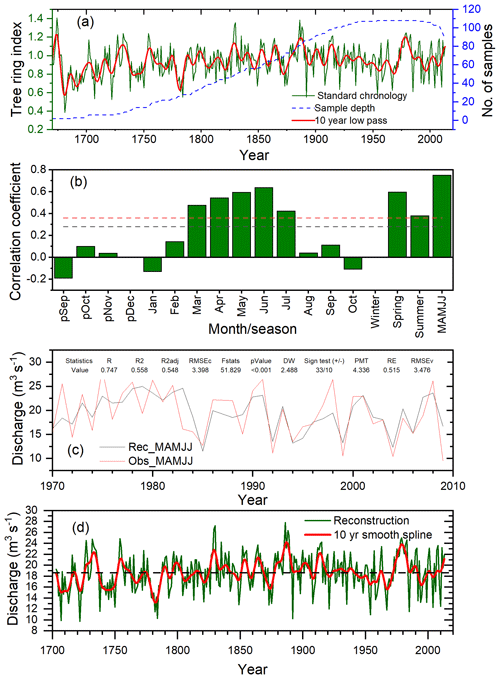
Figure 4Composite tree-ring standard chronology from Sinja River basin, along with the 10-year low-pass smoothing and sample depth (a) and the hydrological response, i.e. relationship (Pearson's correlation coefficient) between the composite tree-ring standard chronology and the monthly and seasonal streamflow data (b). MAMJJ indicates spring–early-summer season. The horizontal dashed line indicates 95 % (black) and 99 % (red) levels of significance of the correlation coefficients. Calibration models (c) and reconstructed spring–summer season (March–July) average streamflow (d) in the Sinja Khola, Karnali basin.
Hydrological response analysis of tree growth revealed a strong positive relationship between the Sinja chronology with monthly streamflow during March to July and the seasonal averages of the spring (MAM), summer (JJAS), and spring–early-summer (MAMJJ) seasons (Fig. 4b) of the current year. The tree-ring chronologies from the Sinja region generally revealed a positive relationship with spring-season (in some cases, both spring- and summer-season) precipitation and drought indices and negative correlations with the temperature during the spring season and, in some cases, also during the summer season (graph not shown). This indicates that the growth of the tree species in the studied region is mainly limited by moisture stress during the beginning or entirety of the growing season.
The streamflow is the result of rainfall, meltwater from snow and glaciers, and water from groundwater storage. The positive relations with streamflow (in addition to the positive response to precipitation) further confirm that the moisture availability limited tree growth in the Sinja valley and adjacent areas. Western Nepal (Karnali basin) receives about 7 % and 12 % of annual precipitation during the winter and spring seasons, respectively (Khatiwada et al., 2016). During the spring season, temperatures generally increase fast and reach their annual maximum. If there is less rainfall during winter and spring, an increasing demand for evaporation due to high temperatures in the late spring leads to moisture stress, limiting the growth of trees (Thapa et al., 2015; Panthi et al., 2017; Liang et al., 2019; Misra et al., 2015).
3.3 Seasonal streamflow reconstruction of the Sinja River
The spring–early-summer season (March–July, MAMJJ) streamflow reconstructions of the Sinja River at Diware, Jumla, using a robust model (MAMJJ) that explains 56 % of the variance in the actual data (Fig. 4c) cover the periods AD 1700 to 2013 and show several pluvial (wet) and drought (dry) periods, with a long decreasing pattern since about 1890 to the 1950s until after the 1980s (Fig. 4d). The low-frequency analysis using a 10-year smoothing spline revealed several persistent dry and wet periods over the reconstruction period (Fig. 4d). Long above-average flow periods (calculated using 10-year smoothing-spline data) were observed during 1726–1736, 1752–1762, 1796–1803, 1826–1842, 1878–1906, 1911–1919, 1924–1934, 1973–1991, and 2007–2013, while long below-average flow periods occurred during 1703–1716, 1737–1751, 1763–1772, 1776–1787, 1804–1813, 1869–1877, 1942–1961, 1964–1972, 1992–1999, and 2002–2006. The recent dry and pluvial periods are synchronous to the dry and wet periods in the precipitation and drought reconstructions from the region (Gaire et al., 2017, 2019; Panthi et al., 2017). Several consecutive moderate to extremely dry and pluvial years (flow beyond 1 and 2 SD from the long-term average) were also recorded. Some of the extremely dry years found in the present study match with the station-data-based drought years (1984–1985, 1987–1988, 1992–1993, 1994–1995, 1999, 2004–2009, and 2012) in the Karnali River basin (Khatiwada and Pandey, 2019). Many extreme-flow periods were observed in the lower reaches of the Karnali basin (Gaire et al., 2022).
Centennial to millennial long tree-ring-based seasonal to annual streamflow reconstructions have been carried out for several rivers in the western Himalayas (Cook et al., 2013; Singh and Yadav, 2013; Mishra et al., 2015) and eastern Himalayas (Shah et al., 2014; Rao et al., 2020), as well as for many rivers in China (Chen et al., 2019; Liu et al., 2020). Some of the dry and wet events of our study match with those streamflow reconstructions from eastern Himalayan rivers like the Lachen “Chu” River, the North Sikkim (Shah et al., 2014), and the Brahmaputra River (Rao et al., 2020), though rivers in the eastern Himalayas are more influenced by the Indian summer monsoon (ISM). The climate of Nepal's (central) Himalayas is influenced by both the ISM and western disturbances; some of the hydro-climatic events match with studies of the western Himalayas, and some match with studies of the eastern Himalayas. A decreasing tendency in Satluj River discharge (Misra et al., 2015), reconstructed using tree-ring data, was recorded from the 1990s, which is similar to our reconstructions.
We observed interannual- to multidecadal-scale (medium-term) periodicities in our March–July streamflow in the Sinja River, as revealed by the power spectral analysis (Fig. 5). Significant (95 % or above) spectral peaks were observed in the periods of 2.2–2.9, 6.2, 6.3, 8.2, 8.7, 35.2, and 36.5 years (Fig. 5). The short and interannual periodicities of 2 to 8 years fall within the El Niño–Southern Oscillation (ENSO) range, which has quasi-biennial variability with a 2.1–2.9-year frequency, together with a lower-frequency (2.5–8.7 years) component (Bridgman and Oliver, 2006). The medium-term (35.2–36.5 years) periodicities are likely to be related to the influence of the Atlantic Multidecadal Oscillation (AMO) and the North Atlantic Oscillation (NAO). The periodicity related to ENSO is one of the dominant forcings in relation to local dryness–wetness variations in the South Asian summer-monsoon-dominated Himalayas (Yadav et al., 2014; Gaire et al., 2017, 2019; Panthi et al., 2017), as well as in the Tibetan plateau and adjacent regions (Gou et al., 2010; Chen et al., 2019).
We present the hydrological sensitivity of multiple tree species from the Nepalese Himalayas and their potential to be used for long-term streamflow reconstructions. The over-3-centuries-long March–July streamflow reconstructions of the Sinja Khola in the Nepalese Himalayas revealed periodic fluctuations in the streamflow, with a continuous decrease after the 1980s, indicating possible water shortages in the warming but drying world anticipated in the future. Since we found periodic (decadal or even longer) below-average streamflows during the last 3 centuries, the streamflow-based water and energy sectors could be affected periodically.
Hydrological data were obtained from the Department of Hydrology and Meteorology, Government of Nepal. Public tree-ring data were accessed from NOAA. The reconstructed data will be available on request to the authors.
NPG did the conceptualization, methodology, formal analysis, and writing – original draft. SKS and FZX also participated in the conceptualization, methodology, and writing – review and editing. YRD did the writing – review and editing.
The contact author has declared that none of the authors has any competing interests.
Publisher's note: Copernicus Publications remains neutral with regard to jurisdictional claims made in the text, published maps, institutional affiliations, or any other geographical representation in this paper. While Copernicus Publications makes every effort to include appropriate place names, the final responsibility lies with the authors.
This article is part of the special issue “Mountain Hydrology and Cryosphere”. It is a result of the International Conference on Mountain Hydrology and Cryosphere, Kathmandu and Dhulikhel, Nepal, 9–10 November 2023.
We thank DHM for the hydro-meteorological data, the Tribhuvan University for the research grant, the DNPWC for the research permissions, NAST and FRTC for the laboratory facilities, and the local field assistants and guides for their support during the fieldwork.
This research has been supported by the Tribhuvan University (grant nos. TU-NPAR-079/80-ERG12 and TU-HERP DLI-7B).
Bolch, T., Kulkarni, A., Kääb, A., Huggel, C., Paul, F., Cogley, J. G., Frey, H., Kargel, J. S., Fujita, K., Scheel, M., Bajracharya, S., and Stoffel, M.: The state and fate of Himalayan glaciers, Science, 336, 310–314, https://doi.org/10.1126/science.1215828, 2012.
Bridgman, H. A. and Oliver, J. E.: The global climate system: patterns, processes, and teleconnections, Cambridge University Press, Cambridge, ISBN 9781107668379, 2006.
Bunn, A. G.: A dendrochronology program library in R (dplR), Dendrochronologia, 26, 115–124, https://doi.org/10.1016/j.dendro.2008.01.002, 2008.
Chaudhary, S., Chettri, N., Adhikari, B., Dan, Z., Gaire, N. P., Shrestha, F., and Wang, L.: Effects of a changing cryosphere on biodiversity and ecosystem services, and response options in the Hindu Kush Himalaya, in: ICIMOD, Water, ice, society, and ecosystems in the Hindu Kush Himalaya: An outlook, edited by: Wester, P., Chaudhary, S., Chettri, N., Jackson, M., Maharjan, A., Nepal, S., and Steiner, J. F., ICIMOD, 123–163, https://doi.org/10.53055/ICIMOD.1032, 2023.
Chen, F., Shang, H. M., and Panyushkina, I. P.: Tree-ring reconstruction of Lhasa River streamflow reveals 472 years of hydrologic change on southern Tibetan Plateau, J. Hydrol., 572, 169–178, https://doi.org/10.1016/j.jhydrol.2019.02.054, 2019.
Cook, E. R. and Kairiukstis, A. (Eds.): Methods of Dendrochronology: Applications in the Environmental Sciences, Kluwer Academic Press, Dordrecht, ISBN 13:978-0792305866, ISBN 10:0792305868, 1990.
Cook, E. R., Palmer, J. G., Ahmed, M., Woodhouse, C. A., Fenwick, P., Zafar, M. U., Wahab, M., and Khan, N.: Five centuries of Upper Indus River flow from tree rings, J. Hydrol., 486, 365–375, https://doi.org/10.1016/j.jhydrol.2013.02.004, 2013.
DHM: Observed Climate Trend Analysis in the Districts and Physiographic Regions of Nepal (1971–2014), Department of Hydrology and Meteorology, Kathmandu, https://www.dhm.gov.np/uploads/dhm/climateService/Observed_Climate_Trend_Analysis_Report_2017.pdf (last access: 28 July 2024), 2017.
Fritts, H. C.: Tree rings and climate, Academic Press, New York, ISBN 9781930665392, 1976.
Gaire, N., Zaw, Z., Bräuning, A., Sharma, B., Dhakal, Y., Timilsena, R., Shah, S. K., Bhuju, D. R., and Fan, Z.: Increasing extreme events in the central Himalaya revealed from a tree-ring based multi-century streamflow reconstruction of Karnali River Basin, J. Hydrol., 610, 127801, https://doi.org/10.1016/j.jhydrol.2022.127801, 2022.
Gaire, N. P., Koirala, M., Bhuju, D. R., Shah, S. K., Carrer, M., and Timilsena, R. R.: Tree-ring based spring precipitation reconstruction in western Nepal Himalaya since AD 1840, Dendrochronologia, 42, 21–30, https://doi.org/10.1016/j.dendro.2016.12.004, 2017.
Gaire, N. P., Dhakal Y. R., Shah, S. K., Fan, Z. X., Bräuning A., Thapa, U. K., Bhandari, U. K., Aryal, S., and Bhuju, D. R.: Drought (scPDSI) reconstruction of trans-Himalayan region of central Himalaya using Pinus wallichiana tree-rings, Palaeogeogr. Palaeoclim. Palaeoecol., 514, 251–264, https://doi.org/10.1016/j.palaeo.2018.10.026, 2019.
Gaire, N. P., Fan, Z.-X., Chhetri, P. K., Shah, S. K., Bhuju, D. R., Wang, J., Sharma, B., Shi, P., and Dhakal, Y. R.: Treeline Dynamics in Nepal Himalaya in a Response to Complexity of Factors, in: Ecology of Himalayan Treeline Ecotone, edtied by: Singh, S. P., Reshi, Z. A., and Joshi, R., Springer, Singapore, 519–563, https://doi.org/10.1007/978-981-19-4476-5_22, 2023.
Gou, X. H., Deng, Y., Chen, F., Yang, M., Fang, K., Gao, L., Yang, T., and Zhang, F.: Tree ring-based streamflow reconstruction for the Upper Yellow River over the past 1234 years, Chin. Sci. Bull., 55, 4179–4186, https://doi.org/10.1007/s11434-010-4215-z, 2010.
ICIMOD: Water, ice, society, and ecosystems in the Hindu Kush Himalaya: An outlook, edited by: Wester, P., Chaudhary, S., Chettri, N., Jackson, M., Maharjan, A., Nepal, S., and Steiner, J. F., ICIMOD, https://doi.org/10.53055/ICIMOD.1028, 2023.
Immerzeel, W. W., van Beek, L. P. H., and Bierkens, M. F. P.: Climate change will affect the Asian water towers, Science, 328, 1382–1385, https://doi.org/10.1126/science.1183188, 2010.
Khatiwada, K. R. and Pandey, V. P.: Characterization of hydro-meteorological drought in Nepal Himalaya: A case of Karnali River Basin, Weather Clim. Extrem., 26, 100239, https://doi.org/10.1016/j.wace.2019.100239, 2019.
Khatiwada, K., Panthi, J., Shrestha, M., and Nepal, S.: Hydro-climatic variability in the Karnali River basin of Nepal Himalaya, Climate, 6, 17, https://doi.org/10.3390/cli4020017, 2016.
Liang, E. Y., Dawadi, B., Pederson, N., Piao, S., Zhu, H., Sigdel, S. R., and Chen, D.: Strong link between large tropical volcanic eruptions and severe droughts prior to monsoon in the central Himalayas revealed by tree-ring records, Sci. Bull., 64, 1018–1023, https://doi.org/10.1016/j.scib.2019.05.002, 2019.
Liu, Y., Song, H. M., and An, Z. S.: Recent anthropogenic curtailing of yellow river runoff and sediment load is unprecedented over the past 500 y, P. Natl. Acad. Sci. USA, 117, 18251–18257, https://doi.org/10.1073/pnas.1922349117, 2020.
Mathison, C., Wiltshire, A. J., Falloon, P., and Challinor, A. J.: South Asia river-flow projections and their implications for water resources, Hydrol. Earth Syst. Sci., 19, 4783–4810, https://doi.org/10.5194/hess-19-4783-2015, 2015.
Michaelsen, J.: Cross-validation in statistical climate forecast models, J. Clim. Appl. Meteorol., 26, 1589–1600, 1987.
Misra, K. G., Yadav, R. R., and Misra, S.: Satluj river flow variations since AD 1660 based on tree-ring network of Himalayan cedar from western Himalaya, India, Quatern. Int., 371, 135–143, https://doi.org/10.1016/j.quaint.2015.01.015, 2015.
Panthi, S., Bräuning, A., Zhou, Z. K., and Fan, Z. X.: Tree rings reveal recent intensified spring drought in the central Himalaya, Nepal, Global Planet. Change 157, 26–34, https://doi.org/10.1016/j.gloplacha.2017.08.012, 2017.
Rao, M. P., Cook, E. R., and Cook, B. I.: Seven centuries of reconstructed Brahmaputra River discharge demonstrate underestimated high discharge and flood hazard frequency, Nat. Commun., 11, 1–10, https://doi.org/10.1038/s41467-020-19795-6, 2020.
Rinn, F.: TSAP-Win: time series analysis and presentation for dendrochronology and related applications, Version 0.55 User reference, Heidelberg, Germany, https://rinntech.info/products/tsap-win/ (last access: 28 July 2024), 2013.
Shah, S. K., Bhattacharyya, A., and Chaudhary, V.: Streamflow reconstruction of Eastern Himalaya River, Lachen `Chhu', North Sikkim, based on tree-ring data of Larix griffithiana from Zemu Glacier basin, Dendrochronologia, 32, 97–106, https://doi.org/10.1016/j.dendro.2014.01.005, 2014.
Singh, J. and Yadav, R. R.: Tree ring based seven century long flow record of Satluj River western Himalaya, India, Quatern. Int., 304, 156–162, https://doi.org/10.1016/j.quaint.2013.03.024, 2013.
Speer, J. H.: Fundamentals of tree ring research, The University of Arizona Press, Tucson, ISBN 13:978-0816526857, ISBN 10:0816526850, 2010.
Talchabhadel, R., Karki, R., Thapa, B. R., Maharjan, M., and Parajuli, B.: Spatio-temporal variability of extreme precipitation in Nepal, Int. J. Climatol., 38, 4296–4313, https://doi.org/10.1002/joc.5669, 2018.
Thapa, U. K., Shah, S. K., Gaire, N. P., and Bhuju, D. R.: Spring temperatures in the far-western Nepal Himalaya since AD 1640 reconstructed from Picea smithiana tree–ring widths, Clim. Dynam., 45, 2069–2081, https://doi.org/10.1007/s00382-014-2457-1, 2015.
Wigley, T. M. L., Briffa, K. R., and Jones, P. D.: On the average value of correlated time series, with applications in dendroclimatology and hydrometeorology, J. Clim. Appl. Meteorol., 23, 201–213, https://doi.org/10.1175/1520-0450(1984)023<0201:OTAVOC>2.0.CO;2, 1984.
Yadav, R. R., Misra, K. G., Kotlia, B. S., and Upreti, N.: Pre-monsoon precipitation variability in Kumaon Himalaya, India over a perspective of ∼300 years, Quatern. Int., 325, 213–219, https://doi.org/10.1016/j.quaint.2013.09.005, 2014.
Zang, C. and Biondi, F.: Treeclim: an R package for the numerical calibration of proxy-climate relationships, Ecography, 38, 431–436, https://doi.org/10.1111/ecog.01335, 2015.






